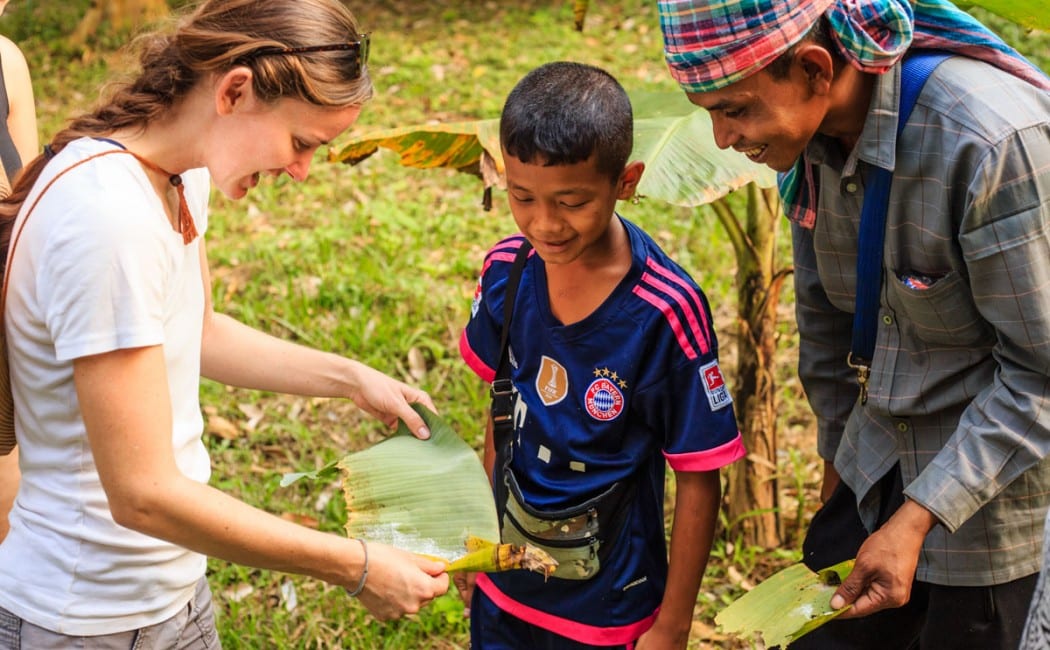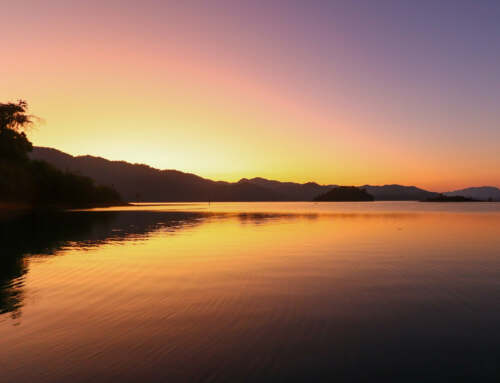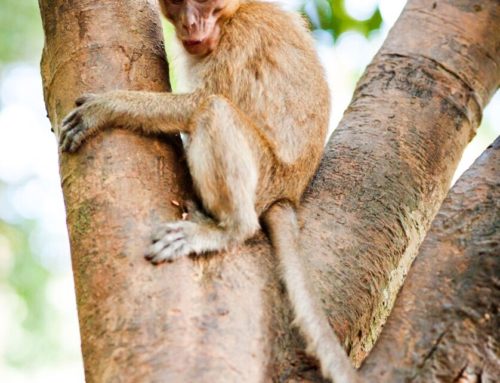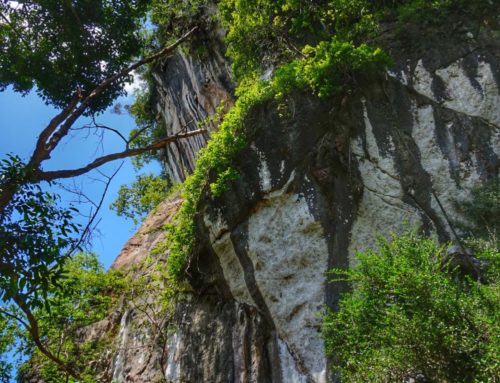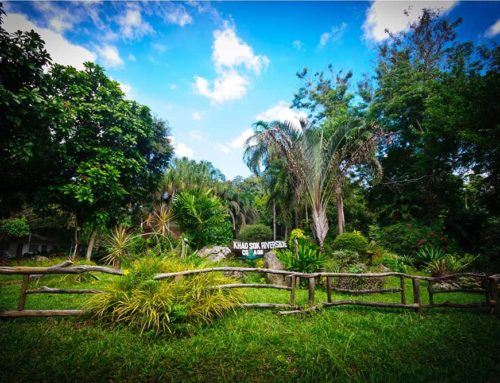Visiting with jungle guides, fruit farmers, and elephants, Alexander Vysniauskas shares how 3 simple concepts are empowering the emergence of Responsible, Community-led Tourism in Khao Sok National Park, Thailand

The fight for the preservation of Thailand’s Khao Sok National Park begins in the late 1970s, with an armed uprising deep in the jungle strongholds of present day Cheow Lan lake. Before the National Park was established, student activists, labeled as communists, were able to keep the encroaching logging and mining companies at bay. The fight against exploitation continues to this day, now against the scourges of modern agriculture and mass tourism.
Khao Sok National Park in Thailand is one of the world’s oldest and most diverse tropical forests. The vast, untouched tropical paradise is rich with wildlife and more than 1500 plant species, including one of the world’s largest flowers – Rafflesia kerii. Wild elephants, tigers, red bull, and gibbons are some of the 48 species of mammals that coexist with the 311 bird species sighted in the area, according to Chiang Mai University’s database.
Since the 1990s, commercial agriculture and tourism in Khao Sok have developed rapidly, with little consideration for the long term effects on the local economy, environment, or culture. For a time, it seemed Khao Sok was on track to become yet another region exploited by mass tourism and palm-oil plantations.
Yet to this day the National Park is still pristine and faces no immediate threats and the area around the park hasn’t been completely overrun by hordes of tourist busses and the cement infrastructure necessary to host them. Local quality of living is on the rise and the list of community led activities and tours is growing while the quality of services is only getting better.
To get a better understanding of what’s happening in Khao Sok, it helps to consider three principles – share what’s there, empower (don’t own), and create champions – that are guiding Khao Sok to the forefront of responsible tourism. Some practical examples will illustrate how these come into play in real-life.
Share What’s There
Two years after the National Park was established, the rising waters of the Cheow Larn Dam displaced the villagers of Khao Pang from their home. Countless animal species were displaced, and Khao Pang was on the brink of losing their agricultural way of life. Seeing that more and more visitors were coming to enjoy the newly created lake, the locals created a community action group and charted a path towards economic stability. Without sacrificing their lifestyle to mass tourism or selling their land to outside investors, they came up with a “Lunch with a Local” program for visitors, complemented by a homestay option for overnight guests.
Working with Bodhi Garrett, a local sustainable tourism expert, village leaders held training workshops for local families ready to share their way of life with respectful visitors. Now Khao Pang village gets around 700 guests yearly, which is a significant secondary source of income, allowing local farmers to keep their fruit crops and continue of their unique way of living.
According to Garrett, “Responsible tourism is about minimizing the negative impact of your travel and directly giving back to the communities you visit. It is about understanding the story behind the price you are paying, and connecting with the local people that make your holidays memorable.”
Visitors to Khao Pang have a chance to interact with the host family through a variety of activities, like picking fruit, going on a hike, having a one-on-one cooking class, and visiting the world-famous scenery of Cheow Larn Lake.
Many aspects of daily life in the jungle are exciting for visitors, creating a bridge between tourism and a community’s culture and values.
Empower (Don’t Own)
For centuries elephants in Southeast Asia have been used to haul lumber, transport crops, or even carry soldiers into battle. Most of these traditions are no longer, but domestic elephants in today’s world are at risk from tourists wanting to ride them.
The sad reality is that many elephant camps do not place animal welfare first, and the elephants are made to entertain guests with tricks. This situation motivated local businessman Aek to take action. For years, Aek had watched Somboon, his family’s elephant, work at a tourist camp without proper medical care or rest. Finally, when he could bear it no longer, Aek approached Garrett, the sustainable tourism guy, and asked for help to establish an Elephant Retirement Sanctuary. With support from Garrett’s North Andaman Foundation, Aek learned the skills he needed to attract volunteers and paying customers to help him care for the elephant.
At the Elephant Retirement Sanctuary, guests have an incredible experience feeding Somboon, who eats 300 kg of food per day, bathing the elephant, and learning about Thai elephant culture, including the secret elephant language. Instead of partnering with a tour company and having to share the income, Aek and his father were able to grow their business using social media. Free of obligations to outside investors, they are now looking forward to helping more elephants retire at their sanctuary, adding a sustainably growing attraction to Khao Sok.
How do you help an elephant retire? Help his owner be self-supporting.
Creating Champions
After the National Park boundaries were established in Khao Sok, 60% of the land in Bang Man village was declared inside the park. Balancing human and natural interests is always hard. Forest lands were protected, but local people no longer had a livelihood Fortunately, the villagers of Bang Man realized they were a gateway to the park, and secured a concession to guide all visitors entering the park through their village. Their trail proved popular for hikers wanting to see the giant Rafflesia flower, but this rare plant only blooms 2-3 months a year, not long enough to make guiding a viable secondary income.
When leaders from Bang Man heard of the Elephant Retirement project, they contacted Bodhi Garrett for help in making a plan. According to Garrett, “The people who want to have a positive impact in their community, those are the people we listen to. Once we understand their priorities, we work with community leaders to figure out a method to accomplish that.”
To achieve long-term success village leaders had to become champions of the community. They learned basic English, developed guiding and safety protocols, and started sharing this knowledge with their fellow community members. The outcome was was the Bang Man Nature Trail – a spectacular route for day-long and overnight hikes, with waterfalls, caves, and giant stone arches.
Further championing local capacity, Garrett and his colleagues have organized local guide trainings, environmental education camps, and a Facebook page to encourage local pride. Their next big project is providing education to undocumented youth who are at risk of child labor and trafficking. Currently there are 3.5 million economic migrants from Myanmar living in Thailand, and no system to provide care for their children. These kids are often forced to work with their parents in dangerous, dirty, and degrading fields of work.
The Burmese Learning Centre was founded to provide stability, hope, and a better future for migrant children. Kids are taught from nursery age to the 6th grade in Burmese, Thai and English, allowing them to continue their education in Thailand or Myanmar. The school accepts international volunteers for 2-4 week teaching rotations, and is largely funded by Bodhi Garrett and responsible tour operator Andaman Discoveries. Garrett elaborates, “Even local businesses can be champions of community development. Education is the cornerstone of self-sufficiency, and donations from the private sector can help make sure that all children go to school.”
Responsible tourism can kick-start positive progress on a much wider scale
For visitors ready to experience the joys of local Thai life, while giving back to the community, a visit to Khao Sok offers plenty to do. Through the cooperative efforts of local leaders and supportive businesses, community-led tourism at Khao Sok National Park is now a success story. For example, Khao Sok Riverside Cottages, a resort under Garrett’s management, has been a key source of funding, meeting space, and guests for the “Lunch with a Local,” elephant retirement, and Bang Man hiking programs.
It wasn’t an easy path, but Garrett has learned that genuinely respectful tourism is possible if you share what’s there. It is important to enable local ownership, and empower locals to be conscientious future leaders.
Bodhi Garrett graduated from UC Berkeley and moved to southern Thailand in 2003; researching sea turtles and working at a remote island eco-resort. He founded North Andaman Tsunami Relief after the December 2004 wave claimed his job, home, and the communities he had come to know and love. The grassroots disaster relief effort grew under his leadership to encompass over 150 projects in 12 villages, including the ongoing North Andaman Foundation. Bodhi’s latest project is Khao Sok Riverside Cottages – learn more at http://www.khaosok.net/


